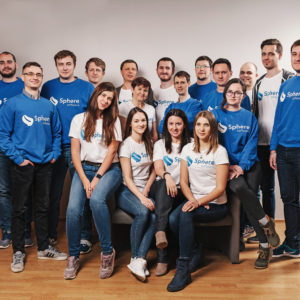How do you outsource better?
When it comes to improving the performance of remote development and consulting teams, keeping them engaged can be a challenge.
- How do you ensure that they’ll be aligned with your mission?
- How do you integrate them and make them part of your team?
- How do you encourage them to contribute ideas with the same enthusiasm as your engaged employees?
- How do you keep them motivated to deliver top-notch work?
- And, how do you ensure a regular stream of productive and consistent back and forth communication?
Gallup’s recent State of the Global Workplace report suggests that only 15% of employees worldwide are engaged in their jobs. Gallup’s research suggests employee disengagement costs companies billions. While the Gallup study did not look at engagement for remote development or outsourced workers, these same numbers could potentially provide a benchmark for understanding engagement with remote contract technical workers. With all the trouble keeping captive employees engaged, how should you think about engagement with your freelance, consultant, and gig workforce? What is the secret for keeping your remote contract developers engaged and productive? How do you outsource better and how do you ensure that your remote contract developers enthusiastically invest in your work? When we started Sphere, we knew culture was important. Today, our culture defines how we communicate, work together, and engage with our clients.
Chairlift Performance Management and 360-degree Feedback Tool
Getting a better handle on our culture is why we developed an internal tool called Chairlift. Chairlift is a performance management and 360-degree feedback tool that elevates employee engagement. Chairlift worked so well that we made it available to our clients so that they could review our developers and our developers could provide feedback to their clients. Maintaining company culture even with a geographically diverse workforce isn’t just something we’re passionate about, it’s become the driving force behind who we are (if you’d like to try Chairlift, please get in touch) After all, it’s a new world. In this new gig economy, companies are relying more and more on consultants and freelancers. Improving engagement with your remote development contract workforce will maximize their productivity, contribution, and expertise.
In addition to constant feedback, we also wanted to know some other ways to improve the performance of a remote contract workforce. We interviewed our own developers and clients and learned about some of the behaviors – when taken together – can dramatically improve the performance of remote teams. We’ve put together these 28 recommended ways to improve your collaboration and engagement with remote development teams. We’re sure we missed a few, so if you’d like to add your tips to the article, please reach out and let us know your thoughts. Here goes…!
OKRs help companies focus on things that are important and can be used throughout your company with staff of any kind – w9 or 1099. When people have clearly defined goals, understand how they can improve, and understand how their actions impact the company, everyone wins.In fact, when your remote contract workforce understand how their goals contribute to the company as a whole, they connect with the company’s culture faster. One person’s accomplishments lift everyone. That sort of cohesiveness creates a connected and fluid culture that moves everyone forward.
In an organization that uses OKRs, objectives are often either set quarterly or annually. However when there is consistent interaction with OKRS, teams remain more motivated and effective. Individual employees tend to thrive in cultures in which they can receive real-time feedback from their colleagues, supervisors and subordinates rather than annual reviews. 360-degree feedback keeps OKRs on track, running smoothly and always in the direction of progress.At a high-level, here are some of the guidelines around implementing OKRs for remote development teams:
- When setting OKRs shoot for quality over quantity, and try not to go over 5 objectives, each with up to 4 key results
- OKRs are set, revisited, graded, refined, and revised throughout the year (typically quarterly and annual cycles)
- OKRs should be made publicly available across the entire remote development team.
- Key results should be measurable, make the objective achievable (or real), and support unbiased grading.
- For more detail on OKRs and how to implement them read through Jay Yarow’s article on the topic.
Having a framework like OKRs is a big step in the right direction. But it isn’t enough. Remote developers should learn your OKR process, their managers should understand your expectations, AND their upper management should become ambassadors for your framework. If your remote PMs and senior leadership understand your overall strategy, they quickly become champions and cheerleaders to your teams.
Successful software development managers view their teams as unified organizations – whether the members are w9s, 1099s, or consultants/vendors. Successful leaders go one step further—and understand that this big collection of people ARE the company and ARE the culture. With OKRs in place, knowing HOW your team is doing as well as WHAT they are doing increases job satisfaction and productivity. The takeaway is simple – in business as in life, there is no substitute for human connection. When you measure what you value, trust is established when your teams work toward and achieve an understood goal. When you hire high performing software developers and consultants, understand that they thrive accountability and transparency, where all projects are tracked and tied to performance reviews. High performers expect to have a stake in your success. If Sarah is in Chicago and Raul is in Kiev, how do you create a unified culture? How do we maintain the same values and approach? Your company’s narrative lives in the voices of your workforce so making sure everyone is in sync should be your first and arguably most important priority.
This first one is pretty easy. You don’t have to have a remote workforce to know that you have to be deliberate about the environment in which you work. A culture already exists within your company so you have to take careful note as to what is working and what isn’t. Are you retaining employees? If not, why? Get to the bottom of it. If you are, then why are people loyal? Find out and be deliberate when continuing to build upon what’s already working. Are customers happy? Who are they interacting with? Find out. Identify the things that are going well and the places in which improvements need to be made. Survey. Make a plan. Put it into action.
So, Sarah is in Chicago. Raul is in Kiev. Jason is the only person in your “London office” which we all know really means “Jason’s living room.” Jason won’t be bringing the entire office his homemade lemon cake on Monday. Raul and Sarah won’t run into each other in the elevator. They won’t share smoke breaks or happy hour. Unless facilitated, they won’t have the non-work related moments and interactions in which they get to know each other on an engaged, human level.You may or may not sign on to Google’s approach to employee happiness by building water slides, sleep pods, and hoverboards for employees, but at the very least, your employees have to talk to each other to feel connected. Set up Skype sessions, a private Facebook group, use HR Software (Chairlift.io), have members or teams contribute to a company blog. This starts from the top on down. Share the company vision and communicate. Internal resources may see the remote team as a potential threat. Eliminate that perception as soon as possible by being upfront, transparent and reiterate that they’re here to help and be a part of the team and are not meant to replace anyone onshore. Create a sense of comradery. Get relationships going beyond just writing code and fixing bugs. Onshore employees should show interest in their offshore teammates.
It may seem like a given that you’ll work hard to find the right fit when hiring for positions within your company. Though sometimes the person most qualified may not be the person that will fit snugly and support the culture. Make sure to use value-based questions when in the interview process to confirm that your hire will indeed be a good fit for your team. And, of course, avoid the brilliant jerk at all costs. What is a brilliant jerk? A brilliant jerk is a high performing employee that is demanding to the point of being abusive, takes too much credit for success, and is unable or unwilling to adhere to commonly shared values of the organization. Jack Welch wrote about “bullies” from his own experience. In 1992, Welch announced that most of the managers asked to leave the company had delivered good financial performance but were shown the door because they “didn’t practice our values.”
Happy employees are productive employees. This goes beyond PTO. When discussing culture, we aren’t just talking money. (We aren’t not talking about money either.) Pay well and provide good benefits. Meet basic needs and baseline happiness follows. Your team depends on strong leadership. Leadership needs to be able to listen, to understand change, and to be responsive. What lifestyle options you can provide? Sometimes that’s a matter of resource. Provide Ipads to remote employees? Maybe. Cover gym memberships? Maybe. What works for your budget? What do your employees want? It’s not only about need. It’s about making your team feel valued. Invest in your employees and in turn they will jump on board and engage full-on with your company’s mission.
When communicating strategy with remote teams, language barriers can often be a stumbling block to effectively communicating strategy. According to mission.org: “Poor communication, uncertain expectations, distant time zones, and even cultural differences can all conspire to undermine any benefits of a remote team.”When communicating strategy across cultures, be approachable. Let your developers know that you are available for any questions or concerns. This will be very important for people that fear retaliation or reprisal for speaking out or for bypassing a formal chain of command. Of course, be respectful. In a multicultural workplace, it can be a challenge to avoid offending people in your communications. Be clear and concise, be approachable but never too familiar. Humor is personal. Many cultures will not appreciate your personal brand of humor. Avoid it until you are certain your jokes will not cause offense.
Even if you think you are doing a good job communicating, you are probably not communicating strategy well. According to the “Barriers to Employee Engagement” study conducted by the Holmes Report, “one-third of executives are not confident that their employees could accurately communicate the company’s business strategy to others and only 19 percent were very confident that their employees could do so.” The good news – your remote developers want to understand the business strategy.
Everyone must understand that one person’s success does not come at the expense of others. Any combination of processes that implement these values will likely work for your team, but not all strategies are the right fit for every team and every project and every organizational context, so it’s important to both try different strategies and also regularly debrief with your team about what’s working and not working. Let team members negotiate for process changes, and stay flexible. Here are five key values for making this happen:
- Acknowledge the team’s diversity of experience
- Clearly state communication and collaboration norms
- Create safe spaces for learning and asking questions
- Explicitly onboard all team members into new projects
- Create a culture of accountability
If you are working with a team in a different time zone, take the time to understand cultural differences. Get to know their culture and who they are. Culture consists of the customs, arts, social institutions, and achievements of a particular nation, people, or other social group.An article on Toggl.com explains that culture is “quite hard to define univocally, as “culture” means slightly different things for every team. Regardless, the general consensus seems to be that culture in a team isn’t about individual performances, personalities or attitudes—it’s about how the team works together as a cohesive unit.”
If you are using an agency or an outside remote development team, look for a supplier that employs full-time engineers and developers that have a dog in the fight, won’t jump ship mid-project, and have a vested interest in your company. How do you tell if someone is committed? There is a story in Scrum about a chicken and a pig. The chicken decides that the two should start a restaurant. The pig likes the idea, is entrepreneurial, and is ready for a change. Out of curiosity, the pig asks a question: “What are we going to call the restaurant?” The chicken thinks about it and says: “How about Ham and Eggs!” Obviously, the pig is not interested because: “I’d be committed. You’d only be involved.”This story is told to point out the difference between commitment and involvement. Commitment in Scrum is often misunderstood as a promise to deliver by a certain date. In reality, commitment is bigger than that. Commitment makes decision making easier. When developers commit to the success of the entire team, this creates an environment of trust, productive problem solving, and high team standards.When everyone commits to delivering value, the team feels a greater sense of shared purpose. This shared purpose increases our motivation to collaborate. Commitment is essential in solving complex problems and growing high performing teams. Once they’re placed within your organization, you want them committed to seeing the assignments through to the very end.
The fact that culture is hard to define does not mean you should not try to define it. According to George Michelson, Vice President of Solutions for Sphere Software, simple things go a long way toward bridging cultural differences. Michelson recommends that software development managers pay attention to simple things such as religious holidays and seek opportunities to expand the local team’s awareness of the remote team’s culture.
Make every team member, no matter their geographic location and distance feel like they are valued, respected and have decision making power at a certain level. This can be accomplished via something as simple as saying thank you to shouting them out on the next team call or awarding them in a rewards/recognition tool.
Your team wants to know how they are doing. Don’t leave them floating out there in the atmosphere and expect them to keep motivated. Check in. Do it more than annually. Do it more than quarterly. As a matter of fact, keep your feedback ongoing with your team. The more you keep your door open, the more you’ll be informed of what’s going on and your team will understand what the overall vision is so that everyone can work together toward it.Feedback is a consistent theme in this article because it is usually not done well. Provide feedback so that your developers know exactly where they stand based on KPIs that have been set up in the onboarding process. Create a culture where employees want to give, receive and solicit feedback to grow both personally and professionally. Show them how they’re performing in terms of contribution to code review, ability to function on your own, ability to write code well without supervision, maintaining accurate documentation, and other metrics you’ve set up. Keep track of how they interact and work with others. Have they formed symbiotic relationships both within their group and cross functionally?According to Rita Ginsburg, CHRO for Sphere Software, “360-degree feedback is one way to hold a mirror up to an employee – it helps them see a more complete picture. Over time, the hope is for each individual to increase their self-knowledge, minimizing blind spots and hidden areas through self-discovery and 360-degree feedback (or feedback from managers, peers, direct reports, and other important stakeholders). The goal is not to become completely transparent or over-share, but to more consciously understand and therefore choose what is shared with others, how one shows up and interacts in the world, and when to make efforts to continue to get to know oneself and others. When businesses support this process of self-discovery and growth in conjunction with clearly communicating the organization’s strategy and how employees can contribute to it, real sustainable change can occur. If either of these are missing, change is much less likely – though, these aren’t the only potential challenges.”
Make sure their career goals are being tracked. Give them a chance to broaden their expertise, with technical training (depending on their level of expertise). Sphere’s George Michelson stresses the importance of event participation. “At Sphere, our developers participate in our monthly global Tech Debates, Annual Conferences, peer training, and other industry events. We encourage all our clients to allow remote team members to participate in company conferences, seminars and even invite them as guest speakers on a panel to share their expertise.
Fly them in! Have a remote employee of the month or quarter, and as a relationship-building exercise, meet with them in person to recognize their loyalty to the company. This will improve morale tremendously. For daily interaction, Sphere uses Google Hangouts and Zoom Conferencing. Zoom combines HD video conferencing and webinars from desktop and mobile in one simple solution. Most people start using Zoom with a free account, then usually upgrade to a paid or enterprise account. For users, the best part is that only one person needs to download Zoom. Everyone else can jump right into a meeting right from their browser. Our IT team loves it, too, because you can use connectors to patch it directly from the Zoom cloud into the internal network.
Upon project initiation, make sure developers have the right requirements that have been approved by key stakeholders. Provide them proper infrastructure and resources they need to execute effectively. This includes access to your systems/databases, collaboration tools, communication channels shared across the organization.
Hire experts that can get the big picture, understand your vision and what you’re trying to achieve. Go through the business objectives, strategy and product roadmap. Offer them the same and/or similar onboarding experience you would your full-time employees (tailored to a contingent worker).
Critical to success is hiring the proper resources. Here’s who we recommend hiring as part of your offshore team:
- A Business Analyst who understands the business objectives/problems, context and landscape and can properly communicate that to the developers. They must be an SME as well as understand technology. It really helps to have someone in that role offshore to assist the developers on their time zone. It’s critical to their productivity.
- A Project Manager to monitor project progress, track milestones, and flag any potential obstacles that may hinder and/or prevent meeting deliverables.
- A Solutions/Systems Architect that will create the necessary architecture and is well-respected in terms of their technical abilities. NOTE: If hiring an outside firm, make sure there’s an additional resource that can step in the event critical issues need to be escalated beyond the above roles (i.e. Client Success Manager)
To stay on top of things efficiently, schedule daily and/or weekly stand up/check-in calls to get status updates. “A structured, disciplined approach to remote work culture can keep your environment flexible yet productive“. – jell.com (See more on how to achieve this in the tech section).
- Work around the time difference
Try to set up meetings during the work hours of your remote teams. Be mindful of the time difference but learn to work within its restraints. In eastern Europe for instance, there is usually a 4 hour overlap of business hours, so morning calls would work best. That way, when it’s the end of day in the US, your remote team can be off troubleshooting and/or coding your next app for multitasking at its’ best!
For project management, consider JIRA, a proprietary issue tracking product developed by Atlassian that allows bug tracking and agile project management.With JIRA, remote teams can be up and running, collaborating and engaging with client teams quickly and efficiently. It gives you full visibility into your team’s workload. You can use it for ticketing/tracking issues, to plan out sprints, create user stories, distribute tasks, prioritize work and time tracking. Note: Typically, consultants work on a 40 hour-per-week basis.Make sure you’re hiring SCRUM certified individuals trained in Agile Methodology and practice Agile Software Development. Agile Methodology is a particular approach to project management that is utilized in software development. This method assists teams in responding to the unpredictability of constructing software. It uses incremental, iterative work sequences that are commonly known as sprints.Or, if you follow alternative methodology such as Waterfall which is far more rigid and breaks down projects into distinct stages, use a comparable project management system that gives you the functionality you need.
“Think globally, code locally.” Collaboration is enabled by technology. For example, we use Google Docs, where multiple people can edit content at the same time which is invaluable and drives productivity. This can pretty much replace physical whiteboards.Try to engage development and QA at the same time so they’re aware of all the challenges upfront, able to identify solutions and mitigate risks further down the line. The sooner you get the developers involved, the better the outcomes.Ensure that developers are reviewing each other’s code. Have them spend some time doing tech support. When there is a client issue, have developer answer tickets to understand the challenges and get client feedback first hand. It doesn’t hurt to also hold weekly user acceptance testing to ensure that everything is built according to the necessary requirements.
Schedule team calls as well as one-on-ones on a regular basis to discuss what’s been done, what they’re doing now and what will be delivered. It’s important to have a clear, holistic view of the project pipeline. Use a reputable online conferencing software capable of hosting online meetings, desktop sharing, and video conferencing such as GotoMeeting, Slack, WebEx, Zoom, Google Hangouts, etc. Set up an individual or group chat using Slack, Skype Business or MS Teams. Ensure the team is constantly connected to management so that they don’t feel disconnected despite their location. That shouldn’t be a barrier for them to be able to voice their opinion.
A knowledge base portal for developers helps track project progress, tasks, and store pertinent documentation. Give remote developers access to your Document Management System (i.e. Confluence) and make sure your supplier gives you access to theirs.
Utilize automated code verification to ensure that the code is kept up to standards you’ve set up. It’s a great sanity check to confirm that your code is running properly, written using the methodology and standards that the organization has set and is easy for others to understand.
Concluding Thoughts
Outsource Better
Simply put, the value of outsourcing is that it gives you broader exposure to diverse talent around the world that you may be missing at home. Working with people from different cultural backgrounds, provides new perspectives, fresh ideas and brings greater creativity to the table. You get the technical thought leadership needed to meet market demands and gain a competitive advantage.
The benefit of outsourcing also lies in its efficiency and risk reduction. When you hire consultants through a trusted partner firm, you need not worry about paying employee benefits or the liabilities that the supplier takes on as their employer of record. Choose one that has strong relationships built over time with a record of delivering stellar work comparable to your needs under tight deadlines and mutually agreed upon budgets. Keep in mind that as much as collaboration is important, you need to find individuals that can work autonomously, with minimal oversight or need for micromanagement, and have a desire to make a real impact. They just need to feel like they’re part of the bigger team and that the lines of communication across the team are always open.
With the right remote development team to supplement your technology group, productivity within your organization will increase your, as full-time employees can then focus on other projects/tasks. Remember, the depth of technical expertise that make up the team, coupled with the type of work environment you create can mean the difference between developing something ordinary or extraordinary, innovative and dare we say groundbreaking.
Looking for a remote team of workers that bring a diverse set of skills to bring your vision to life? Learn more about our teams on-demand here and contact us today.











